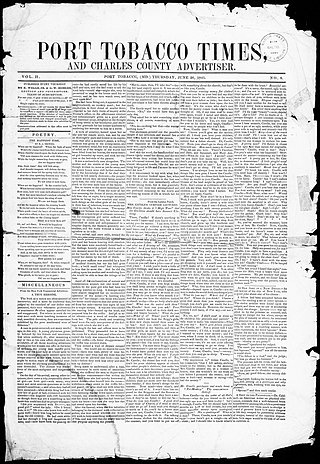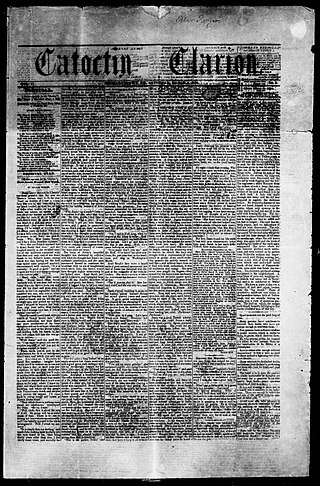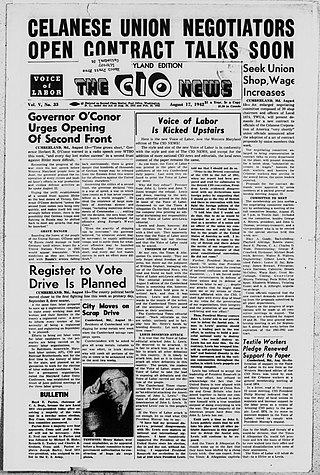The Missoulian is a daily newspaper printed in Missoula, Montana, United States. The newspaper has been owned by Lee Enterprises since 1959. The Missoulian is the largest published newspaper in Western Montana, and is distributed throughout the city of Missoula, and most of Western Montana.
The Star Democrat is an American newspaper published and mainly distributed in Easton, Maryland, in Talbot County, as well as in the surrounding counties of Caroline, Dorchester, Queen Anne's and Kent. The Star Democrat is published on Wednesdays, Thursdays, Fridays and Sundays. The Tuesday edition is currently digital only.
The Capital, the Sunday edition is called The Sunday Capital, is a daily newspaper published by Capital Gazette Communications in Annapolis, Maryland, to serve the city of Annapolis, much of Anne Arundel County, and neighboring Kent Island in Queen Anne's County. First published as the Evening Capital on May 12, 1884, the newspaper switched to mornings on March 9, 2015.
The Aegis is a local newspaper in Harford County, Maryland, United States. Its first issue was published on February 2, 1923.

The Port Tobacco Times was a newspaper published from 1844 to January 14, 1898 in Port Tobacco, Charles County, Maryland. It was founded as a Democratic newspaper by Elijah Wells Jr. and G. W. Hodges. In 1845, the name of the paper was changed to the Port Tobacco Times and Charles County Advertiser but retained its original founders as editors and publishers. When Union troops were stationed in Port Tobacco at the start of the American Civil War in 1861, Wells had to reassure alarmed pro-Confederate readers that the Times had not been seized by Union soldiers - rather, he had only allowed the soldiers to borrow his printing equipment to publish a newspaper for the troops stationed nearby. The Times published an editorial, entitled "Our Situation," in response:
“The State of Maryland has cast her vote for the Union and Government by the largest majority ever known to this State… Charles County then stands before the Government and the world this day a loyal county. Charles County has ever been loyal; we challenge a disloyal act to be laid at her door - and yet what is her condition? As a loyal county and State, obedient to the recognized law, faithful to the Constitution, the citizens of this State have a right, and undisputed right to protection in their person and property. Twenty thousand Federal troops are stationed upon the soil of Charles County, their camps extending from Mattawoman Creek to Liverpool Point. These troops are here ‘For our protection,’ we are told; ‘to protect us form the Rebels,’ and yet, in fact, we are exposed to more danger, to more losses and damage or at least as much as if these very Rebels were here. Our farmers are deprived of their provender to such extent that their cattle must die. Our citizens are deprived of homes almost; and fencers, farms, and field falls prey to the ruthless hands of those very friends who come here to protect us. “Our negroes, - ah, this is the point, - our negroes - are taken from us time and again, with no remuneration and the threats of violence if we seek to recover them.””

The Salem Register was a newspaper published in Salem, Massachusetts, in the 19th century. William Carlton established it in 1800; subsequent publishers included his wife Elizabeth Carlton, John Chapman, Charles W. Palfray, Warick Palfray Jr., Haven Poole, Eben N. Walton. Among the contributing writers: William Bentley, Andrew Dunlap, Joseph E. Sprague, Joseph Story. Its office was at no.185 Essex Street.
The American Republican and Baltimore Daily Clipper was a newspaper published in Baltimore, Maryland in the mid-1800s. The paper supported slavery but opposed Confederate secession in the American Civil War, based on the premise that it would be possible to maintain slavery under the Union.

The Civilian & Telegraph was a Unionist newspaper published weekly in Cumberland, Maryland, from 1859 to 1905. It was created on March 17, 1859, from the merger of two newspapers, the Civilian and Telegraph. William Evans and John J. Maupin were the first editors.

The Daily Exchange was a daily newspaper published in Baltimore, Maryland, United States from 1858 to 1861. It was originally owned and edited by Charles G. Kerr and Thomas Hall Jr. In 1859, Henry Fitzhugh, William Carpenter, and Frank Key Howard bought into the paper. Howard soon headed the editorial staff and Severn Teackle Wallis contributed editorial columns frequently.

The Catoctin Clarion was a weekly newspaper published in Thurmont, Maryland, United States, from March 4, 1871, to 1942. The paper was named for the nearby Catoctin Mountain located west of Mechanicstown. Contents included local, state, national and international news briefs; stories from Frederick County history; market news; poetry and literature in "a rare selection of instructive Reading"; letters to the editor, and advertisements, being called a "sprightly sheet of neat appearance... conducted with ability". The paper measured 18 by 24 inches and ran on Thursdays.
The Western Maryland Democrat was a weekly newspaper published from March 1863 to April 13, 1865 in Westminster, Maryland. The paper's equipment and premises were destroyed by an angry mob in April 1865 in the wake of the assassination of Abraham Lincoln, and a few weeks later the paper's founder, Joseph Shaw, was attacked and murdered. Jesse Glass has written extensively on Joseph Shaw and his murder. The Democrat's successor, The Democratic Advocate, literally rose from its ashes when William H. Davis established the paper in November 1865.

The St. Mary's Beacon was a weekly newspaper published from December 13, 1839, to June 10, 1983, in Leonardtown, Maryland, U.S. Its headquarters was originally located on Washington Street in Leonardtown, a building which was formerly the Old Town Tavern.

The Democratic Messenger was a weekly newspaper published in Snow Hill, Maryland from January 30, 1869 to February 21, 1973, making it Worcester County's oldest newspaper. It ceased publication when it was merged with the existing publication Worcester Democrat to form the Worcester County Messenger. It was founded by T. H. Moore and George M. Upshur to consistently promote Democratic politics, which in turn reflected the conservative attitudes of the population of Worcester County.
The Baltimore County Advocate was a weekly newspaper published in Towsontown, Baltimore, Maryland from February 24, 1850 to December 31, 1864. It was founded by Eleazer F. Church, who had previous experience as a printer for the Doylestown Democrat, and started the Advocate in order to promote the municipal separation of Baltimore County and Baltimore city as well as African American emancipation. The paper's headquarters was relocated from Baltimore to Towson, the new county seat, in 1853. Church sold the paper in 1865 to Henry C. Longnecker and his brother John, who renamed the publication to The Baltimore County Union.

The Baltimore County Union was a weekly newspaper published in Towsontown, Baltimore, Maryland from January 7, 1865 to June 8, 1912. When John H. Longnecker combined his pro-Union paper, the Baltimore County American, with the Baltimore County Advocate to create The Baltimore County Union, he placed his sons Henry and John in charge of the new weekly. Its inaugural issue claimed that it had the "largest circulation of any county paper in the State." The publication's main competitor in Towsontown was the Maryland Journal, a Democratic paper run by William H. Ruby.

The Voice of Labor was a biweekly newspaper covering issues related to the labor movement and was published from December 1, 1938, to July 30, 1942, in Cumberland, Allegany County, Maryland, after which point it became the Western Maryland edition of The CIO News. It was originally founded in 1937 by labor activists James Blackwell and Clyde D. Lucas as The Voice during a time of great upheaval in the American labor movement. The paper was published by the Western Maryland Industrial Union Council of the Congress of Industrial Organizations (CIO). Blackwell was a veteran labor organizer and left-wing agitator who had previously led the People's Unemployment League in Baltimore and the city's United Auto Workers. He acted as the paper's inaugural managing editor until June 1941. Lucas was a native of western Maryland and leader of the textile workers at the massive Celanese plant in Cumberland.

The Worcester Democrat was a weekly newspaper published from 1898 to February 22, 1973, in Pocomoke City, Worcester County, Maryland. It was founded by Samuel M. Crockett, a Democratic politician who served in the Maryland House of Delegates for two terms, 1920–1922. Crockett had learned the newspaper business as a young man working at the Somerset Herald in Princess Anne, Maryland, and was also owner of another local paper, the Peninsula-Ledger. In January 1921, the publication changed its name to the Worcester Democrat and the Ledger-Enterprise after it absorbed the successor of the Peninsula-Ledger, the Ledger-Enterprise. This remained the title until September 24, 1953, when it was changed back to its original Worcester Democrat. On March 1, 1973, the Democrat merged with nearby Snow Hill's Democratic Messenger to form the Worcester County Messenger. This newspaper remained in publication until at least 1980.

The Delaware Straight-Out Truth Teller was an American semi-monthly newspaper based in Wilmington, Delaware. It was founded in 1872 by William Dean and John A. Brown in response to political dissension in relation to the United States presidential election of that year. The paper supported the Straight-Out Democratic Party presidential candidate Charles O'Conor and was a strong opposer of Liberal Republican Party candidate Horace Greeley. Its motto was "O'Conor & Adams; Honesty, Patriotism and Statesmanship." The paper appears to have ceased publishing after the election ended.
Henry Vanderford was an American politician and newspaperman from Maryland. He served as a member of the Maryland House of Delegates, representing Carroll County from 1874 to 1876, and served in the Maryland Senate from 1880 to 1884.










